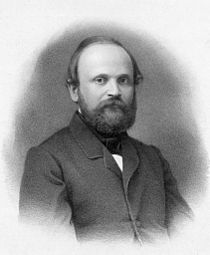Robert Remak facts for kids
Quick facts for kids
Robert Remak
|
|
|---|---|

Remak c. 1850-1855
|
|
| Born | 12 July 1815 |
| Died | August 29, 1865 (aged 50) |
| Alma mater | University of Berlin |
| Known for | Ectoderm, mesoderm and endoderm |
| Scientific career | |
| Fields | Embryology Physiology Neurology |
| Doctoral advisor | Ferdinand Georg Frobenius Hermann Amandus Schwarz |
Robert Remak (born July 26, 1815 – died August 29, 1865) was a brilliant scientist from Germany. He studied how living things work and grow. He was an embryologist (someone who studies embryos), a physiologist (someone who studies how bodies work), and a neurologist (someone who studies the nervous system). Remak made a very important discovery: all cells come from other cells that already exist. This idea changed how we understand life!
Contents
Cells: Where Do They Come From?
Robert Remak found out that new cells are made when older cells divide. He saw this happening in the red blood cells of chicken embryos. He watched them divide into new cells. Then, he saw the same thing in frog eggs right after they were fertilized. This showed him that cell division is a universal process. It happens everywhere in living things!
This discovery was very important. It helped explain why Louis Pasteur's experiments showed that life does not just appear out of nowhere. Instead, new life and new cells always come from existing life and cells.
Robert Remak's Studies and Discoveries
Remak earned his medical degree in Berlin in 1838. He focused on neurology, which is the study of the brain and nerves. He made several other key discoveries about the human body.
Understanding Embryos
Remak is well-known for simplifying how we understand germ layers. These are the first layers of cells that form in an embryo. Another scientist, Karl Ernst von Baer, had described four layers. Remak showed there were actually three main ones:
- The ectoderm: This layer forms the skin and nervous system.
- The mesoderm: This layer forms muscles, bones, and blood.
- The endoderm: This layer forms the lining of organs like the stomach and lungs.
Discovering Nerve Parts
Remak also found special parts of the nervous system. He discovered nerve fibers that do not have a protective covering called myelin. He also found groups of nerve cells in the heart. These are sometimes called Remak's ganglia after him.
Facing Challenges
Even though Robert Remak made many important discoveries, he faced difficulties. Because he was Jewish, he was not allowed to become a full professor for a long time. This was unfair. Later in his life, he was finally appointed as an assistant professor. He was the first Jewish person to teach at that institute. Sadly, he was never fully recognized for all his amazing work during his lifetime.
Robert Remak's son, Ernst Julius Remak, also became a neurologist. His grandson, Robert Remak, was a mathematician.
See also
 In Spanish: Robert Remak para niños
In Spanish: Robert Remak para niños

